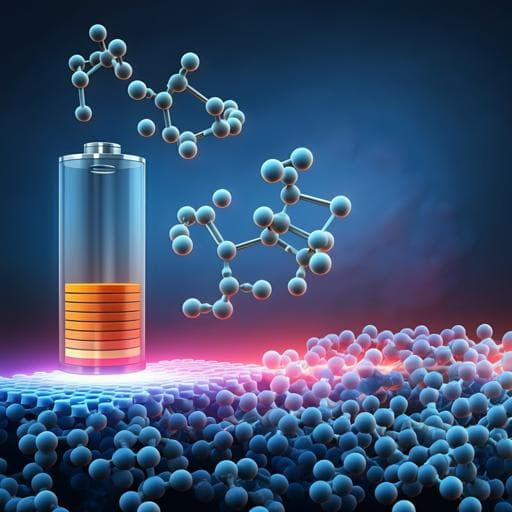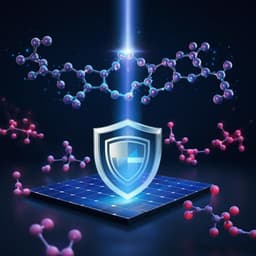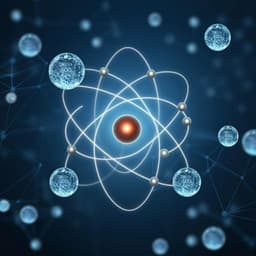
Engineering and Technology
Electrochemical nitrate reduction in acid enables high-efficiency ammonia synthesis and high-voltage pollutes-based fuel cells
R. Zhang, C. Li, et al.
This innovative research, conducted by Rong Zhang and colleagues, reveals the remarkable ability of TiO₂ nanosheets for rapid nitrate reduction to ammonia in acidic conditions. By hybridizing with iron phthalocyanine, they've developed a highly efficient catalyst, paving the way for advances in energy conversion and environmental recovery through an alkaline-acid hybrid Zn-nitrate battery.
~3 min • Beginner • English
Introduction
Ammonia is a critical feedstock for fertilizers, pharmaceuticals, and nitrogen-containing chemicals and is increasingly viewed as an energy and hydrogen carrier. Electrochemical nitrate reduction (NO₃⁻ RR) to ammonia has gained attention due to nitrate’s abundance (e.g., in wastewater), offering higher ammonia yield efficiency and lower energy consumption than N₂ reduction and the Haber–Bosch process. However, most studies focus on neutral/alkaline media, where large overpotentials and sluggish kinetics arise from the need to supply protons via water dissociation, and nitrite is often a byproduct at the beginning. Local pH increase can also volatilize in situ produced NH₃, complicating capture. In contrast, acidic NO₃⁻ RR offers advantages: minimized NH₃ volatilization, direct formation of ammonium salts (e.g., NH₄NO₃, (NH₄)₂SO₄), and abundant protons to accelerate hydrogenation steps. Yet, acidic operation suffers from strong competition from the hydrogen evolution reaction (HER) and catalyst instability of many late-transition-metal systems in acid. Here, the authors propose TiO₂ nanosheets (intrinsically poor for HER) as a platform for selective and rapid acidic NO₃⁻ RR, and further enhance performance by hybridizing with iron phthalocyanine (FePc) to boost NO₃⁻ adsorption, suppress HER, and lower the energy barrier of the rate-determining step. They also demonstrate an alkaline–acid hybrid Zn–nitrate battery leveraging the acidic cathode, and a hydrazine–nitrate fuel cell for pollutant remediation with electricity generation.
Literature Review
Prior work on NO₃⁻ RR has largely centered on neutral/alkaline conditions with late transition metal catalysts (Cu, Fe, Co, Ni), achieving high faradaic efficiencies but often generating NO₂⁻ initially and requiring large overpotentials due to proton supply via water dissociation. Local high pH can lead to NH₃ volatilization, necessitating acid capture. Acidic NO₃⁻ RR is less explored because many catalysts are unstable in acid and HER is strongly competitive. TiO₂ has been used due to poor HER activity and corrosion resistance. NOx-based electrochemical battery systems (e.g., Zn–NO₃ batteries) have been reported: early galvanic cells showed OCVs around 0.81–1.22 V with very low power densities, and a rechargeable Zn–nitrogen flow battery achieved 1.39 V OCV and 10.0 mW cm⁻² power density. The best reported galvanic Zn–NO₃ battery (neutral/alkaline catholyte) reached 70.7 mW cm⁻² with a 0.94 V OCV using CuNi catalysts. There remains a need for higher voltage, power density, and selectivity, motivating exploration of acidic cathodes and improved catalysts like metallophthalocyanines (e.g., FePc), known for stability in acid and poor HER activity.
Methodology
- Catalyst synthesis: Fe phthalocyanine (FePc) was hybridized onto TiO₂ nanosheets via a simple wet chemical process, yielding FePc/TiO₂ with Pc molecules attached through a Fe–O chemical bond and van der Waals interactions. Variants FePc/TiO₂-x were prepared with different treatment times (3, 6, 9 h; x=1,2,3). FePc loading variations were studied to assess mass activity.
- Materials characterization: SEM and EDS mapping confirmed nanosheet morphology and uniform distribution of Ti, O, Fe, N, C; XRD showed TiO₂ peaks (FePc content low); Raman and FTIR identified signatures of FePc and TiO₂. Double-layer capacitance estimated electrochemically active surface area differences. Post-electrolysis, SEM, XRD, FTIR, EDS mappings, and XPS (Ti 2p, N 1s) were used to assess structural/chemical stability and intermediates; ICP-MS quantified metal dissolution.
- Electrochemical testing: Linear sweep voltammetry (LSV), Tafel analysis, and electrochemical impedance spectroscopy (Nyquist plots) were performed for NO₃⁻ RR across pH 1, 7, and 13; activation energies were derived from temperature-dependent LSVs (293–303 K). Faradaic efficiencies (FEs) and yields of NH₃, NO₂⁻, and N₂H₄ were quantified by UV–Vis with calibration curves. NO₃⁻ concentration effects (0.1–2.0 M) were evaluated. SCN⁻ poisoning experiments probed Fe active sites. In-situ FTIR (thin-layer cell) identified adsorbed intermediates versus potential.
- Isotope labeling and NMR: ¹⁵NO₃⁻ and ¹⁴NO₃⁻ electrolytes were electrolyzed at −0.45 V; ¹H NMR distinguished ¹⁵NH₄⁺ and ¹⁴NH₄⁺ for cross-validation of NH₃ yields/FEs against UV–Vis.
- Computational details: Spin-polarized DFT (VASP) with PBE-GGA and PAW; DFT-D3(BJ) dispersion; 450 eV cutoff; force convergence 0.05 eV/Å. Anatase-TiO₂(101) surface optimized with 3×3×1 k-point; Γ-point for TiO₂/FePc. Calculated adsorption geometries/energies, charge density differences, PDOS, and Gibbs free energy profiles for NO₃⁻ RR and HER on TiO₂, FePc, and FePc/TiO₂.
- Device assembly: An alkaline–acidic hybrid Zn–NO₃ battery (AAHZNB) was assembled using FePc/TiO₂-2 as the acidic cathode and Zn metal in alkaline anolyte, separated by a bipolar membrane to prevent neutralization and exploit pH gradient. Discharge tests measured OCV, polarization, power density, and NH₃ production/FE. A hydrazine–nitrate fuel cell configuration was also explored to simultaneously convert N₂H₄/NO₃⁻ and generate electricity. Application demonstration included powering environmental sulfur recovery.
Key Findings
- Acidic vs neutral/alkaline operation with TiO₂:
- Acidic (pH 1) NO₃⁻ RR shows more positive onset potential and higher current density than neutral/alkaline across potentials; lower ohmic resistance and faster kinetics (Tafel, EIS).
- Activation energy at −0.25 V: pH 1 Ea = 10.7 kJ mol⁻¹, lower than pH 7 and 13, indicating reduced barriers in acid.
- TiO₂ NH₃ FE: pH 1 achieves up to 78.5% at −0.25 V vs RHE; neutral 74.3% at −0.45 V; alkaline 68.8% at −0.45 V. pH 1 maintains 66–78.5% FE from −0.05 to −0.55 V.
- FePc/TiO₂ catalyst performance (acidic, typically 0.5 M NO₃⁻):
- All samples (FePc, TiO₂, FePc/TiO₂-x) show poor HER activity in acid; currents increase markedly with NO₃⁻ present.
- FePc/TiO₂-2 exhibits the highest activity among variants; increasing NO₃⁻ concentration enhances current, NH₃ yield, and FE.
- NH₃ formation rate rises with NO₃⁻ concentration: up to 22.5 mg h⁻¹ cm⁻² at −0.75 V in 2 M NO₃⁻; FE in 2 M NO₃⁻ reaches 92.7%.
- At 0.5 M NO₃⁻: peak NH₃ FE 90.6% at −0.25 V; FE >85% from −0.15 to −0.55 V; maintains 68.7% at −0.75 V. NH₃ partial current density reaches 219.7 mA cm⁻² (NH₃ yield 17.4 mg h⁻¹ cm⁻²) at −0.65 V.
- NO₂⁻ detected initially but FE decreases with more negative potentials; hydrazine negligible.
- FePc alone peaks at 76.0% FE (−0.45 V); FePc/TiO₂-2 surpasses most TiO₂-based catalysts and some acidic systems (e.g., RuCu, Fe₂M-MOFs).
- Selectivity, source verification, and stability:
- ¹H NMR with ¹⁵NO₃⁻/¹⁴NO₃⁻ confirms NH₃ origin and quantification: at −0.45 V, NH₃ yields 11.2 (85.0% FE) and 11.8 mg h⁻¹ cm⁻² (88.7% FE), consistent with UV–Vis.
- 24 h electrolysis: current stabilizes after initial slight drop; NH₃ FE declines modestly from 86.6% to 81.9% in final 6 h. ICP-MS shows Fe dissolution 5.17 wt% (first 4 h) rising to ~20 wt% after 24 h; Ti also detectable.
- XPS: Ti 2p shifts to lower binding energies with negative potential (more reduced Ti); N 1s shows adsorbed NO₃⁻ (~408.5 eV) and surface NH₃ (~397 eV); Fe–N signal weakens at more negative potentials. SCN⁻ poisoning suppresses performance, supporting Fe active sites.
- In-situ FTIR detects intermediates (NO, NOH, NH₂, NH₂OH, NH₃), supporting pathway: NO₃⁻ → *NO₃ → *NO₂ → *NO → *NOH → *NH₂OH → *NH₃.
- Theory:
- FePc binds TiO₂ via Fe–O (~2.28 Å) with interaction energy ~−2.55 eV and charge transfer (0.12 e); NO₃⁻ adsorbs preferentially at Fe (adsorption energy 1.48 eV), with stronger Fe–NO₃ bonding (PDOS evidence).
- Rate-determining step on FePc/TiO₂ is formation of NOH* (ΔG‡ ≈ 0.74 eV); on FePc, NO→NOH barrier ≈ 0.81 eV; on TiO₂, NH₃ desorption is limiting (≥1.29 eV). FePc/TiO₂ is more active and displays HER inertness (HER ΔG ≈ 0.42 eV) compared to TiO₂ (−0.06 eV) and FePc (0.38 eV).
- Device demonstration (AAHZNB):
- Alkaline–acid hybrid Zn–NO₃ battery with bipolar membrane achieves OCV 1.99 V and peak power density 91.4 mW cm⁻², exceeding prior Zn–NO₃ reports.
- During discharge: peak NH₃ FE 88.2% at 0.7 V and NH₃ yield 12.3 mg h⁻¹ cm⁻² at 0.4 V. Demonstrated powering of environmental sulfur recovery and operation of an N₂H₄–NO₃⁻ fuel cell for simultaneous pollutant conversion and electricity generation.
Discussion
Operating NO₃⁻ RR in acid provides abundant protons, avoiding the kinetic penalty of water dissociation in neutral/alkaline media and suppressing NH₃ volatilization, thereby enhancing both activity and selectivity. TiO₂’s intrinsically low HER activity and corrosion resistance make it suitable for acidic NO₃⁻ RR. Hybridization with FePc strengthens NO₃⁻ adsorption at Fe sites, suppresses HER, and lowers the free energy barrier for the rate-determining step (NO→NOH), as supported by in-situ FTIR and DFT. The FePc/TiO₂ catalyst thus achieves high NH₃ formation rates and faradaic efficiencies over a broad potential window in acid, with negligible hydrazine formation and manageable NO₂⁻ byproduct that diminishes at more negative potentials. Although some Fe (and Ti) dissolution occurs under prolonged acidic electrolysis, the catalyst maintains structure and performance reasonably well over 24 h.
The alkaline–acid hybrid Zn–NO₃ battery leverages the high cathodic potential and kinetics of acidic NO₃⁻ RR together with Zn oxidation in alkaline media and a bipolar membrane to prevent neutralization, yielding a record-high OCV (1.99 V) and power density (91.4 mW cm⁻²) for Zn–NO₃ systems while concurrently synthesizing NH₃ with high FE. The platform further enables value-added environmental applications such as sulfur recovery and hydrazine/nitrate co-remediation with electricity generation, illustrating the broader relevance of acidic NO₃⁻ RR to energy conversion and pollution control.
Conclusion
The study establishes acidic electrochemical nitrate reduction as a compelling route for efficient ammonia synthesis, addressing limitations of neutral/alkaline operation. TiO₂ nanosheets serve as a robust acidic platform, and FePc hybridization (FePc/TiO₂) enhances NO₃⁻ adsorption, suppresses HER, and reduces the kinetic barrier for the rate-determining step, delivering high NH₃ formation rates (up to 22.5 mg h⁻¹ cm⁻² at high NO₃⁻ concentration) and high selectivity (peak FE 90.6% at −0.25 V in 0.5 M NO₃⁻; 92.7% in 2 M NO₃⁻). The catalyst demonstrates sustained performance over extended operation, and mechanistic insights from in-situ FTIR and DFT corroborate a pathway involving NO→NOH as the critical step. An alkaline–acid hybrid Zn–NO₃ battery with a bipolar membrane achieves an OCV of 1.99 V and 91.4 mW cm⁻² power density while producing NH₃ with high FE, and is applicable to pollutant treatment scenarios including sulfur recovery and hydrazine–nitrate fuel cells. Future work should focus on improving long-term acid stability, mitigating metal dissolution, optimizing membrane/cell designs, and scaling catalyst synthesis for practical deployment.
Limitations
- Catalyst stability in strong acid over long durations: ICP-MS shows Fe dissolution of 5.17 wt% in the first 4 h, increasing to ~20 wt% after 24 h; Ti is also detectable in solution, correlating with slight performance decline.
- Initial formation of NO₂⁻ byproduct, although it decreases at more negative potentials.
- While FePc/TiO₂-2 outperforms many TiO₂-based catalysts and some acidic systems, a performance gap remains relative to state-of-the-art NO₃⁻ RR catalysts reported in alkaline media at high NO₃⁻ concentrations.
- Detailed rechargeability and long-term cycling of the demonstrated Zn–NO₃ battery configuration were not addressed; the study focuses on galvanic discharge performance.
Related Publications
Explore these studies to deepen your understanding of the subject.







